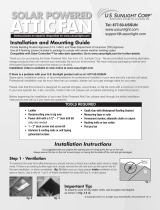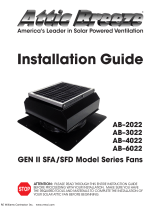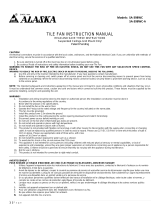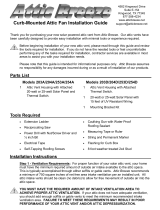Page is loading ...

Installation and Mounting Guide
Florida Building Product Approval (# FL 14561) and Texas Department of Insurance (TDI) Approval
Use all 8 flashing screws included in package to comply with severe weather building codes.
Compatible with Solar Controller™ for after dark operation. Go to www.ussunlight.com for further details.
Thank you for purchasing the Solar Powered Attic Fan from U.S. Sunlight Corp. We are committed to providing alternative
energy products that can improve your everyday life and our environment. We have reduced packaging material and
eliminated Styrofoam to reduce the impact on landfills.
Installation video is available to view online at www.ussunlight.com.
If there is a problem with your U.S. Sunlight product call us at 1-877-50-USSUN
Spare parts, installation advice, or recommendations for professional installers in your area are only a phone call away.
Professional installation may be much less than you expect, please call us to get average rates for your area.
Please note that this product is designed for asphalt shingles, wood shake, or flat tile roofs with a minimum of 4/12 pitch.
If you have spanish tile, s-tile, concrete, metal or flat roof, please call us before attempting to install the product.
Before beginning the installation of your new Solar Powered Attic Fan, please read through the entire installation
instructions and call us if you have any questions.
TOOLS REQUIRED
• Ladder
• Reciprocating saw or jig saw
• Power drill with a 1/2” – 1” inch drill bit
(only one needed)
• 1 – 2” deck screw and screw bit
• Hammer & roong nails or self taping
galvanized screws
• Caulk Gun with Waterproof Roong Sealant
• Measuring tape or ruler
• Permanent marker, sidewalk chalk or crayon
• Roong knife or box cutter
• Flat pry bar
Installation Instructions
It is suggested that you prepare the opening prior to bringing the fan up on the roof.
Always secure the fan on the roof to avoid injury or having the fan slide off the roof and get damaged.
Step 1 - Ventilation
To maximize the solar fan’s effectiveness you should remove or block any rooftop static vents or ridge
vents. If there is an existing turbine type vent, simply remove the old vent and use the same hole for
the new installation, or block completely. (fig. 1) Make sure you have proper intake ventilation at the
eave or fascia. Use a ratio of 1 sq. ft. of intake ventilation for every 600 sq. ft. of attic space.
Important Tip:
To properly close off any static vents, use tar paper and staples
as shown in (fig. 2 & 3).
fig. 2 fig. 3
fig. 1
Block or
Remove
© Copyright 2016 Air Vent, Inc. 9/2016 Rev1
Solar Powered
Attic Fan

Mounting the Fan
Step 2 – Sizing Requirements
See sizing chart on the product box or visit our website at www.ussunlight.com to assure that you select the correct number of
fans for your situation. Some attics have walled off or chambered areas that will require additional fans to properly vent the space.
If you have any questions or concerns please call our customer service specialists at: 1-877-50-USSUN
south or southwest
mid-day summer sun
Step 3 – Positioning of the Solar Fan
The solar fan should be positioned to face south or southwest for optimum performance and should be
positioned on an area of the roof that is not shaded or otherwise blocked from the sun for extended periods
throughout the day. The solar fan should be installed 18 – 24 inches from the top of the roof peak and as
close to the mid-point of your house as possible. In the case that 2 or more fans are getting installed you
should separate the fans by at least 15 feet to optimize ventilation. (fig. 4)
Step 4 – Marking the Hole
From inside the attic, measure down from the roof peak approximately 18 to 24 inches and center this
spot between two rafters. Drill a screw through this mark into the plywood and roof shingle so it will be
easily located from on top of the roof.
Some models include in the box a template for cutting out the hole. It is printed on the cardboard protect-
ing the base of the fan. Punch out the template. From on top of the roof, locate the screw and place the
cardboard template over the top of the screw aligning it in the center hole of the template. Using a pen
or marker, trace a circle around the outer edge of the template, resulting in a circle with a 14” diameter.
(fig. 5) If your product box does not include the template, simply use a 7” string, one end attached to the
previously drilled screw and the other tied to a pen or marker to create a 14” diameter circle.
fig. 4
fig. 5
Step 5 – Cutting the Hole
Using a power drill equipped with a ½ - 1” drill bit, drill a pilot hole anywhere along the
inside of the circle. Insert the saw blade into the pilot hole and follow the circle pattern to cut the hole
into the roof. (fig. 6)
fig. 6
Do not cut through any roofing rafters or framing members! Only cut and remove the roof sheeting and
shingles. Prior to cutting the hole, make sure you do not have any wires or waterlines in the area that
you are cutting. Before completely cutting out the circle, secure the removed material so it does not fall
into the attic space.
5”
Shingle
Felt Paper
Step 6 – Lifting the Shingles
The nails located 5” above and to the side of the hole will need to be removed for the solar fan flashing
to slip between the felt paper and the shingles – (fig. 7) You should use a pry bar or reciprocating saw
to loosen or cut any nails and/or staples.
Do not attempt to force the unit into place. If it does not slide easily into place, a nail is most likely
obstructing the flashing. In some cases the builder may have used large washers to install the felt
paper. In this case lift up on the flashing as you are sliding it under the shingles.
fig. 7
24”
roof peak
Step 7 – Installing the Solar Fan
Position the Solar Fan so that it is directly below the hole (fig. 8a) using the “Up” label
as a guide for orientation. Begin sliding the flashing of the Solar Fan underneath the
shingles and on top of the felt paper at the mid-point of the hole (fig. 8b). Continue sliding
the solar fan upward (making sure that the top of flashing is facing toward the top of the
roof) until it is positioned directly over the attic hole (fig. 8c). To comply with Florida Build-
ing Codes and TDI, remove shingles from all around the flashing and secure all 8 holes.
fig. 8a
fig. 8b
fig. 8c
Step 8 – Securing the Solar Fan
Using the provided steel screws, secure the solar fan to the roof. The solar fan should be secured across the
bottom and on the sides of the flashing by driving screws through the visible pre-drilled holes at the bottom edge
of the flashing. To comply with Florida building codes and TDI, secure in all eight holes. Apply waterproof roofing
sealant to the screw heads (fig. 9). Use roofing nails as needed to secure any shingles that remain loose. Apply
waterproof roofing sealant to the backside of any loose shingles or nail heads that have been added.
fig. 9
If your fan comes with the solar panel detached, refer to Step 9a or 9b
for solar panel installation.

Mounting the Solar Panel
Step 9A – Mounting onto the Solar Attic Fan
Loosen and remove screw A on the solar panel (both sides) to allow the panel to swing away
from the base. Set the screws aside. (fig. 10) Pull the wire from the top of the fan housing
through the hole in the center of the panel base and lay the panel down so the bolts come
through the adjusting slots in the panel base. (fig. 11 and fig. 12) Tighten the bolts on the
panel base at the desired angle for optimal panel direction.(fig. 13)
Step 9B – Mounting Remotely
Use the Quick Connector cable coming through the top of the solar attic fan shroud
(fig. 15) and connect the wire extension directly to this cable (included in some models
or order as an accessory from www.ussunlight.com). Use the other end of the exten-
sion wire to attach to the solar panel.
Use roofing staples to secure the extension cable to the roof.
Fans including 20 watt panels and larger come equipped with 15 feet of additional
wire to remotely mount the solar panel. Additional wire extensions can be purchased
at www.ussunlight.com for installations up to 90 feet away.
Choose a location for the solar panel that will receive optimal afternoon sun, prefer-
ably southwest facing, and free of shade from trees or other buildings.
Loosen and remove screw A on the solar panel (both
sides) to allow the panel to swing away from the base. Set
the screws aside. (fig. 18)
Mount the solar panel base using four 3” galvanized
screws, (fig. 19) making sure to seal the screw holes with
a roof tile adhesive as shown (fig. 20). Tilt the panel away
from the base while installing the screws. If the panel is
to remain flat against the base when installed, it is recom-
mended that you allow the roof tile adhesive to completely
dry before contacting with the panel.
fig. 10
fig. 18
fig. 11 fig. 12 fig. 13
fig. 14
fig. 15
screw A
screw A
fig. 19
fig. 20
Attach the cable coming from the junction box to the cable coming
from the top of the fan with the quick connector. (fig. 14)
We recommend remote mounting solar panels 30 watts and larger, refer to Step 9B.

Additional Accessory Available
The Solar Controller
™
has a built in thermostat and humidistat that will measure the attic tempera-
ture and humidity and allow the fan to have extend run time in the evenings or when no solar is
available. Visit www.ussunlight.com for additional information.
™
Thermal Switch - Optional Installation
If your solar fan unit did not come with the thermal switch, it is available for purchase as an accessory
at www.ussunlight.com. The thermal switch will shut down the fan when the temperature drops below
approximately 65˚F and turn the fan back on when the attic temperature rises to approximately 80˚F. To
install the thermal switch, remove the BLACK lead from the fan motor and attach it to the thermal switch.
Attach the other lead from the thermal switch to the BLACK terminal on the motor. Secure the wires to the
motor bracket with tape or zip ties to prevent them from interfering with the fan blade. If you prefer to have
the fan running during cooler seasons to remove moisture from the attic, do not install the thermal switch
(fig. 15). As an upgrade from the mechanical thermal switch, utilize the Solar Controller with an
electronic thermostat and humidistat as well as additional features. Thermal switch must be removed
upon installation of the Solar Controller.
thermal switch
red lead
(leave as is)
black lead from thermal switch
connected to black terminal on motor
original black lead from solar panel to motor
fig. 15
This solar fan will automatically start whenever the sun shines on the solar panel. Always exercise caution when in the vicinity of the fan.
To avoid accidents, use appropriate attire: safety glasses, gloves, hard hats, restraints and other appropriate equipment.
Use this product only as indicated by U.S. Sunlight Corp. Any questions on appropriate applications, call 1-877-50-USSUN.
Installation work and electrical wiring must be done by qualified person(s) in accordance with all applicable building codes and
standards, including fire requirements.
To prevent back drafting of any fuel burning equipment in the attic such as a gas furnace, sufficient air is needed for proper combustion
and exhausting of gases through the flue of fuel burning equipment. Follow the requirements made by the heating unit’s manufacturer.
Additionally, follow safety standards set fort by the National Fire Protection Association (NFPA), and the American Society for Heating,
Refrigeration and Air Conditioning Engineers (ASHRAE), and the local code authorities.
Maintenance Tip: The solar panel is most effective when clean and free of dust, leaves, and
debris. Normally, rainwater will cleanse the solar panel and keep it operating at peak efficiency.
If necessary, simply hose off the solar panel between rain showers.
Adjusting the Fan
Step 10 – Adjustments
The fan’s solar panel should be adjusted to maximize exposure to the sun’s path during the day. The
optimal adjustment is to have the panel 90 degrees to the midday path of the sun. You can re-adjust
the panel during winter or summer seasons if desired. (fig. 10)
To adjust the tilt of the panel
Remove screw “A” on both sides of the panel assembly and set aside. (fig. 11) Lift the panel and swing panel braces up to desired
position and re-attach screw “A” in the appropriate holes. There are 3 positions to choose from. (fig. 12)
To adjust the rotation of the panel
Loosen nut “B” (there are four) (fig. 13), then rotate the panel base to the desired position (fig. 14) and re-tighten
the nuts. The panel base can be rotated up to 360 degrees by completely removing nuts “B”, lifting the assembly
off the bolts and re-positioning accordingly. Re-attach the nuts and tighten when completed.
The sun’s path
at midday.
fig. 10
fig. 11
fig. 12
fig. 13 fig. 14
re-attach
screw A
Screw A
Nut B
Tel: 877-50-USSUN
www.ussunlight.com
suppor[email protected]
4117 Pinnacle Point Dr.
Suite 400
Dallas, TX 75211
www.airvent.com
ventilation@gibraltar1.com
1-800-AIR-VENT (247-8368)

Manufacturer’s Limited Warranty
U. S. Sunlight Corp. (“Manufacturer”) warrants that certain of its product components are free from defects of workmanship and/or materials
for a period of time commencing on the date of original purchase and continuing as noted hereafter: (a) attic fan motors for a period of ve (5)
years (b) solar panels for a period of twenty (20) years (c) attic fan housings for a period of twenty (20) years. The term “defects” means that
the product functionality is impaired.
Disclaimer
Except as expressly set forth herein, all Manufacturer’s products, including components thereof, are sold “AS IS” without warranty of
merchantability, tness for intended purpose, or other warranty, express or implied. In no event shall Manufacturer be liable for the loss of
prots, indirect, special, incidental, consequential or other similar damages, including but not limited to any claim or demand arising out of the
installation, furnishing, or functioning of a product or use by purchaser or any third party. The warranty terms and conditions detailed above
do not extend to misuse, neglect, abuse, alteration, exposure to extreme weather conditions, lightning strikes, physical damage to any
product, or damages caused by transportation or installation of any product. Manufacturer explicitly does not warrant any labor, shipping, or
service fees incurred by purchaser for the replacement, repair, or exchange of any product or product components claimed under the above
warranty terms and conditions.
Warranty Claims
Warranty claims shall be submitted in writing to Manufacturer at its principal place of business. Claims shall include a copy of the original
purchase invoice, purchaser’s name, address, telephone number, and e-mail address, and such other particulars as are necessary to
describe the claimed defect. If requested by Manufacturer, purchaser shall ship the claimed defective component(s) to Manufacturer’s
principal place of business, FOB destination, freight prepaid, for evaluation. As to any product component determined by Manufacturer to
contain a defect covered by its warranty, Manufacturer reserves the right, at its discretion, to repair or replace the defective component, or
rebate a portion of the purchase price prorated based on the balance of the warranty term.
General
This limited warranty contains all of the terms and conditions of Manufacturer’s warranty of the purchased product and its components. No
representation, arrangement, or agreement not appearing herein shall be binding on Manufacturer. This limited warranty is issued in and shall
be governed by the laws of the State of Nevada.
WARRANTY
CUT HERE
REGISTRATION
WE WOULD LOVE TO HEAR FROM YOU!
To register please visit our website: www.ussunlight.com
or simply ll out this form and mail to:
Name ________________________________________________________Phone____________________________________
___
_
Address ___________________________________________________________________________________________________
City __________________________________________________________ State ______________ Zip _____________________
Email _____________________________________________________ Would you like to be included in our newsletter? Y or N
Product Name __________________________________________ Date of Purchase ___________________________________
Purchased From ______________________ Name of Installer _____________________________________________ (self )
Phone # of Installer ___________________ How satised are you with the install? Not Satised Somewhat Very
Comments ____________________________________________________________________
________________________
4117 Pinnacle Point Dr. Suite 400 | Dallas, Texas 75211
We will not sell or share your email. Only used for product notifications.
/













